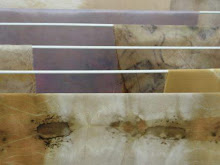Subscribe to:
Post Comments (Atom)
skip to main |
skip to sidebar

projects, visions and observations by

- Maria Julkunen
- Nelson, Aotearoa, New Zealand
- Transforming the world one stitch at a time. Fashion, art, ecodyeing. Colour, contrast, shape, balance, proportion and how that relates to the human experience. Seeker and finder, treading lightly and speaking gently.
broken link remedy
The blog has just relocated to http://fibreoflife.blogspot.co.nz/. Until the fairies that retype url's on broken links get to work you can find your way by replacing the word "fibrefinger" with "fibreoflife" when the link refers to another post on this blog. Thank you!
Labels
100% hemp
(1)
100% wool
(1)
15 minutes a day
(3)
2012
(3)
2013
(2)
akeake
(1)
Andi Regan
(1)
Anton Corbijn
(1)
appreciation
(2)
Arctic Spell
(1)
art
(2)
Arthur's Pass
(1)
artist portrait
(1)
artist statement
(1)
bag
(2)
beauty break
(3)
beginners
(1)
beginnings
(14)
Blenheim
(1)
blind
(1)
Blip (on the Love Radar)
(2)
bloom
(3)
bodice
(5)
capsule wardrobe
(1)
challenge
(3)
changing threads
(3)
Christmas
(3)
circles
(4)
clamping
(1)
clearout
(1)
clothes
(3)
clothes swap
(1)
coffee
(1)
colour
(4)
community
(5)
conscious
(1)
contact
(1)
container
(1)
control
(1)
cost
(1)
craft
(1)
creating
(5)
Creative Journeys
(1)
crochet
(2)
cushion cover
(1)
cutting
(1)
debrief
(1)
design
(2)
draping
(1)
dress
(10)
Durga
(1)
dyer's chamomile
(1)
eco colour
(6)
Ecofest
(1)
Ecopunk Couture
(1)
exhibition
(14)
expressing emotions
(1)
facebook
(1)
fair trade
(2)
falafel
(1)
family
(2)
fashion
(2)
fear
(1)
feline friends
(2)
felt
(8)
fibre art
(2)
fibre of life sewing room
(1)
Finland
(1)
floor talk
(1)
Fox
(1)
Franz Josef
(1)
from doing to being
(1)
From Finland with Love
(2)
glacier
(1)
global
(1)
goal
(1)
goldenrod
(2)
gratitude
(5)
growing
(1)
guide
(1)
hand sewing
(1)
hapa zome
(2)
happy
(1)
harvest
(1)
healing
(1)
heart tracks
(1)
hessian
(6)
hopi amaranth
(2)
how to
(2)
ice
(1)
ice flower dyes
(1)
Iittala
(1)
India Flint
(3)
instant gratification
(1)
interior
(1)
invitation
(1)
Isel Park
(1)
Ishna Jacobs
(4)
January
(1)
journal
(1)
Julkunen
(1)
kids
(1)
knitting
(3)
kohl & cochineal
(1)
Kultaturve
(5)
landskins
(4)
layers
(1)
light
(1)
liquorice plant
(1)
love
(9)
masked parade
(1)
mounting
(1)
nelson
(7)
New Year
(2)
newsprint
(1)
nuno
(1)
nz
(2)
online shop
(1)
organise
(1)
paint
(1)
paisley
(1)
palm fibre
(1)
pattern
(3)
Pattern Magic
(1)
peace
(1)
peat
(4)
photo shoot
(4)
Pinterest
(1)
planning
(1)
plant collecting
(1)
plant dyeing
(12)
printing blocks
(1)
process
(3)
product
(1)
progress
(2)
punch
(1)
R
(6)
red cabbage
(1)
Refinery Artspace
(7)
remembering
(1)
repeat pattern
(1)
review
(1)
roles and masks
(1)
sculpture
(2)
separation
(1)
sewing
(3)
sewing workshops
(3)
sharing a journey
(2)
shoelaces
(1)
silk
(6)
skirt
(6)
Smirnoff International Fashion Awards
(1)
solanum nigrum
(2)
spring
(4)
stitch
(4)
strands
(6)
style
(1)
Summer School
(1)
table
(1)
tea
(1)
thank you
(3)
the box
(2)
The Un-Wedding Dress
(1)
tidy up
(1)
together
(1)
Tomoko Nakamichi
(1)
top
(1)
travel
(1)
upcycling
(4)
vest
(1)
Waimea College
(1)
walk
(4)
wardrobe clean out
(1)
weaving
(1)
weeds
(1)
weld
(3)
window
(1)
woad
(2)
wool
(1)
Wreck this cloth
(3)
Wreck this Journal
(1)








Joyce Lloyd [NZ author of a book on your local dyes] achieved a blue from them. i never had blue here in Oz, but when I was working in New Orleans in November had delicious blue prints from the berries
ReplyDeleteCan I plz know the results of dyeing with black nightshades
ReplyDeleteHi! What was the book on natural dyes? I’m interested in purchasing it. Thanks!
ReplyDelete